#all eyes on majdal shams
Explore tagged Tumblr posts
Text
sorry but fuck the entire world for their silence concerning what happened in majdal shams. fuck you all fuck you fuck you so so much. i thought you cared about children??? thought you cared about “brown children”??? huh??? nothing??? fuck you.
#doesn’t matter cuz they’re israeli which is jewish-adjacent enough for y’all to be gross and conspiratorial about children dying on a soccer#field#like …. i don’t have words#i don’t#israel#all eyes on majdal shams
263 notes
·
View notes
Text
instagram
3 notes
·
View notes
Text
Also a reminder that Hezbollah had been, in fact, targeting multiple civilians (including children) for decades.
Source: I grew up in the north. I REMEMBER.
~
Also, you can see multiple Syrians celebrate the attack.
Why?
Bc during the civil war, Hezbollah has committed multiple atrocities.
(But it's arabs killing arabs, so who cares?*)
those are the same people who laughed during the siege on Mas'aya, as children starved to death.
(when aid workers were finally able to enter the area, they said they entered a city of "walking skeletons")

Google Translate:
After the huge media campaign to distort the image of the resistance, I decided to join the non-violent youth. This is the picture #Solidarity with Madaya Note: #God's curse be upon the Jewish messengers

Why do Syrians gloat over Hezbollah deaths?
Because the children of Houla who were slaughtered with knives,
And the children of Homs and Daraa whose homes were destroyed by artillery fire,
and the children of Aleppo and Idlib on whom explosive barrels were dropped,
and the children of Madaya, who were gloated over as they starved to death during the siege,
and the children of Ghouta who were suffocated with chemical weapons, were innocent
(as always, feel free to correct any of my translations.)
* I have a LOT to say about the way it is framed. This is so fucking racist, the way ppl act as if violence is just a natural result. Bc for THOSE PEOPLE, obviously there is no other way. Not like they can be CIVILISED or have things such as diplomacy.
And the way it's sugar coated? Making it look like it's a moral issue? "Oh, we can't force OUR western ideals on them. They have their traditions, we should support it!"
Well, traditions and cultures are food and communication and stories. NOT this.)
the same people who say the pager attack targeted civilians (it didn't) also didn't give a fuck when hezbollah murdered twelve CIVILIAN children playing soccer.
#this#majdal shams#all eyes on Majdal Shams#Syria#homs#daraa#hezbollah#idlib#aleppo#madaya#ghouta#houla#civil war#syrian civil war#history#western hypocrisy#racism
137 notes
·
View notes
Text

12 Israeli children are massacred and over 34 others are wounded in a rocket attack by Hezbollah terrorists. Where is the international outrage? Are all eyes on Majdal Shams….?
#israelisunderattack#pray for israel#stand with israel#swords of iron#war crimes are being committed#hamas is isis#bring them home now#babies are being butchered#hamas massacre#never again#hezbollah#rocket attack
18 notes
·
View notes
Text
GRAPHIC CONTENT AHEAD
All Eyes on Majdal Shams!
4 notes
·
View notes
Text
Eyes on the world #204

Le news non vanno in ferie (per ora). Prima edizione di agosto piuttosto piena.
Partiamo, come di consueto, dalle notizie provenienti dalla Striscia di Gaza, passando poi per il Venezuela e le sue elezioni presidenziali. Facciamo quindi un salto in Cina dove Giorgia Meloni ha fatto visita alle alte sfere locali, fino alle Olimpiadi di Parigi, iniziate in grande stile.
Partiamo subito 👇
🇮🇱 ISRAELE-HAMAS, IL CONFLITTO SI COMPLICA. LIBANO E IRAN IN ALLERTA PER UNA POSSIBILE ESCALATION
1) Cominciamo da dove avevamo lasciato il conflitto tra Israele e Hamas. Nella notte tra sabato e domenica scorsi, l'esercito israeliano ha attaccato con droni sette località in Libano in risposta a un razzo che sabato aveva ucciso 12 bambini e ferito altre 29 persone a Majdal Shams, nelle Alture del Golan. Questo attacco è il più grave subito da Israele dal 7 ottobre 2023, quando Hamas aveva ucciso e rapito centinaia di persone in territorio israeliano, portando all'invasione israeliana della Striscia di Gaza. Israele ha attribuito l'attacco al gruppo paramilitare libanese Hezbollah, che ha negato il coinvolgimento. Domenica, Israele ha riunito il gabinetto di guerra e iniziato a colpire obiettivi nel sud del Libano, preannunciando una possibile escalation del conflitto. L'esercito israeliano ha identificato il razzo come un Falaq-1 iraniano, tipico di Hezbollah, mentre la Casa Bianca ha concordato con Israele. Hezbollah, invece, ha dichiarato che l'esplosione è stata causata da un razzo israeliano. Da inizio conflitto, ci sono stati lanci quotidiani di razzi e droni kamikaze da Hezbollah e bombardamenti israeliani in risposta, alimentando timori di un'escalation. Il primo ministro israeliano Netanyahu ha promesso che Hezbollah pagherà per l'attacco, mentre rappresentanti delle Nazioni Unite hanno esortato alla calma per evitare una catastrofe regionale. Anche il governo libanese ha condannato la violenza e chiesto la cessazione delle ostilità. Non è ancora chiaro se gli attacchi israeliani abbiano causato vittime, ma l'aviazione israeliana ha affermato di aver colpito obiettivi terroristici. La situazione si è inasprita nel corso della settimana; martedì l'esercito israeliano ha compiuto un attacco a Beirut, capitale del Libano, uccidendo Fuad Shukr, comandante di Hezbollah responsabile del lancio del razzo lanciato a Majdal Shams. Israele considera Shukr a capo del progetto missilistico di Hezbollah e il dipartimento di stato USA aveva offerto una taglia di cinque milioni di dollari per il suo ruolo nell'attentato del 1983 a una caserma statunitense a Beirut. Il ministro della Difesa israeliano ha dichiarato che Hezbollah aveva "oltrepassato la linea rossa". Hezbollah ha definito l'attacco "stupido" e minacciato ritorsioni, mentre la Casa Bianca ha ribadito che una guerra non è inevitabile e ha sottolineato l'importanza della diplomazia. Il primo ministro libanese ha condannato l'attacco definendolo "criminale", e altri gruppi come Hamas, Houthi e la Russia hanno criticato Israele per la violazione del diritto internazionale.
La notizia più importante della settimana è però un’altra. Hamas ha annunciato che Ismail Haniyeh, il capo politico del gruppo, è stato ucciso a Teheran in un attacco aereo delle forze armate israeliane. Haniyeh, 62 anni, viveva principalmente in Qatar dal 2017, coordinando le attività politiche di Hamas. Si trovava in Iran per l'insediamento del presidente Massoud Pezeshkian. La Guida Suprema iraniana Ali Khamenei ha dichiarato che Israele merita una dura punizione e che Teheran vendicherà Haniyeh. Come capo del Politburo di Hamas, aveva un'influenza limitata a causa della distanza dalla Striscia di Gaza e dalla Cisgiordania, ma non è chiaro quanto fosse coinvolto negli attacchi del 7 ottobre 2023 contro civili israeliani. Considerato pragmatico dai leader di diversi paesi, Haniyeh era visto come moderato rispetto ai leader armati di Hamas. È stato una figura centrale di Hamas per trent'anni, nato nel 1962 nel campo profughi di Shati, si unì al gruppo durante la prima Intifada. Fu segretario personale del fondatore Ahmed Yassin e divenne capo di Hamas a Gaza nel 2006. Dopo il ritiro israeliano da Gaza, il governo crollò e Hamas espulse Fatah dalla Striscia. Dal 2017, Haniyeh era capo del Politburo e ha rafforzato l'alleanza con l'Iran. Tre dei suoi figli sono stati uccisi in un attacco israeliano nell'aprile scorso. L’uccisione del leader potrebbe compromettere gravemente i negoziati per un cessate il fuoco nella Striscia di Gaza, dal momento che Haniyeh era un negoziatore chiave e sostenitore del dialogo con Israele. La sua morte indebolisce la fazione pro-negoziati all'interno di Hamas, complicando ulteriormente le trattative. La leadership di Hamas, già decimata dalla guerra, avrà difficoltà a sostituirlo, con Khaled Meshal che potrebbe essere il successore, ma le sue posizioni sui negoziati sono incerte. Israele potrebbe sfruttare l'omicidio per dichiarare una vittoria simbolica o rallentare le trattative. Ma come è avvenuta l’uccisione di Haniyeh? Fino a giovedì, l'omicidio era attribuito a un attacco aereo israeliano. Tuttavia, il New York Times e altri media internazionali hanno riferito che Haniyeh è stato ucciso da una bomba piazzata mesi fa da Israele nella sua residenza, poi fatta esplodere a distanza. Le fonti sono anonime, ma plausibili, e indicano un fallimento della sicurezza iraniana. Israele non ha riconosciuto ufficialmente l'uccisione, ma la responsabilità è quasi certa. Se confermata, questa versione metterebbe in difficoltà l'intelligence iraniana, che non avrebbe rilevato la bomba per due mesi. I media iraniani inizialmente avevano parlato di un attacco missilistico, ma successivamente hanno negato la versione della bomba. Infine, quali saranno le prossime mosse di Israele? Il paese si prepara a una possibile risposta militare dall'Iran e dai suoi alleati, tra cui Hezbollah, già colpito dall'uccisione di un suo leader da parte di Israele. L'Iran aveva attaccato simbolicamente Israele ad aprile, ma l'attacco atteso ora potrebbe essere più ampio e senza preavvisi. L'esercito israeliano è in massima allerta e si sta coordinando con gli Stati Uniti, che hanno inviato rinforzi militari. Gli analisti prevedono attacchi più estesi e da più fronti, che potrebbero aumentare il rischio di una guerra più ampia, anche se nessuno degli attori principali sembra volerla iniziare.
🇻🇪 VENEZUELA: NICOLAS MADURO CONFERMATO PRESIDENTE, TRA PRESUNTI BROGLI, PROTESTE E REPRESSIONE
2) Il Consiglio elettorale del Venezuela ha dichiarato che il presidente Nicolás Maduro ha vinto le elezioni presidenziali con il 51,2% dei voti contro il 44,2% del suo principale avversario, Edmundo González, prima di aver completato lo scrutinio dei voti. L'affluenza è stata del 59%. Tuttavia, l'opposizione ha denunciato brogli elettorali e ha affermato che contesterà la vittoria di Maduro, accusato di governare in modo autoritario dal 2013. Gli osservatori dell'opposizione sono stati spesso allontanati dai seggi, impedendo la verifica della regolarità del voto. María Corina Machado, leader dell'opposizione a cui era stato vietato partecipare alle elezioni, ha rifiutato di riconoscere i risultati, dichiarando González come il vero vincitore con il 70% dei voti. Numerosi leader internazionali, tra cui il presidente cileno Gabriel Boric e il segretario di stato statunitense Antony Blinken, hanno espresso dubbi sulla trasparenza del processo elettorale e hanno richiesto una verifica indipendente dei voti. Al contrario, i presidenti di Cuba, Nicaragua, Bolivia e Honduras hanno riconosciuto la vittoria di Maduro. Altri nove paesi sudamericani hanno richiesto un controllo indipendente, mentre il presidente argentino Javier Milei e l'Alto rappresentante per gli Affari esteri dell'UE Josep Borrell hanno chiesto trasparenza nei risultati. La vittoria di Maduro è stata riconosciuta dai suoi alleati regionali e da altri governi autocratici come Russia, Cina, Iran e Siria. Maduro ha dichiarato che non permetterà violenze post-elettorali e ha menzionato un presunto attacco hacker al Consiglio elettorale. Le elezioni si sono tenute nel settantesimo anniversario della nascita di Hugo Chávez, a cui Maduro ha reso omaggio.
Le speranze di Maduro di un post-elezioni tranquillo sono state subito messe da parte. Lunedì sera migliaia di persone hanno protestato contro i risultati elettorali che hanno confermato la vittoria del presidente uscente, Nicolás Maduro. Le manifestazioni, concentrate a Caracas, sono state disperse con lacrimogeni e proiettili di gomma, causando la morte di almeno quattro persone e l'arresto di 749 manifestanti. Le proteste, diffuse in 20 dei 23 stati venezuelani, sono state seguite da una massiccia presenza delle forze dell'ordine. L'opposizione, che ha dichiarato come "presidente eletto" il proprio candidato, Edmundo González Urrutia, basandosi sul 73,2% delle ricevute del voto elettronico, ha chiesto un raduno pacifico per martedì. González ha affermato di possedere prove della loro vittoria. In risposta alle verifiche richieste da paesi sudamericani e non, il governo venezuelano ha ritirato il personale diplomatico dalle ambasciate nei paesi critici. Tra l’altro, durante le proteste contro i presunti brogli elettorali, i manifestanti hanno abbattuto diverse statue dell’ex presidente Hugo Chávez, fondatore del regime socialista attualmente guidato da Nicolás Maduro. Questo atto simbolico riflette il crescente malcontento, poiché Chávez era una figura generalmente amata nonostante le controversie.
🇮🇹 GIORGIA MELONI IN CINA PER QUESTIONI COMMERCIALI E NON. NEL FRATTEMPO NELLE CARCERI ITALIANE...
3) Dal 28 al 31 luglio, Giorgia Meloni è stata in Cina per una missione diplomatica. La visita si è concentrata a Pechino, dove ha incontrato il primo ministro Li Qiang e incontrerà il presidente Xi Jinping e Zhao Leji, dirigente del Partito Comunista. Successivamente, Meloni si è recata a Shanghai per colloqui con Chen Jining. È la prima visita di un capo di governo italiano in Cina dal 2019, quando Giuseppe Conte partecipò a un forum sulla "Via della Seta". Meloni, che ha preso le distanze dalla Cina su alcune questioni, cerca di mantenere buone relazioni commerciali con il paese, fondamentali per molte aziende italiane. Nel 2019, l'Italia aderì alla Via della Seta sotto il governo Conte, suscitando critiche dagli alleati occidentali. Tuttavia, l'accordo non ha portato ai risultati commerciali sperati per l'Italia, mentre le esportazioni cinesi in Italia sono aumentate. Di conseguenza, Meloni ha deciso di uscire dall'accordo, riallineando la politica estera italiana con quella del G7. Questa decisione potrebbe comportare ritorsioni commerciali cinesi, motivo per cui Meloni ha rilanciato il "Partenariato strategico globale" per salvaguardare le relazioni economiche. Il viaggio ha avuto l’obiettivo di rilanciare il rapporto bilaterale, con possibili accordi industriali, e a discutere della guerra in Ucraina, dove la Cina ha un ruolo cruciale.
Tornando all’incontro, durante il colloquio di un'ora e mezza con il presidente Xi Jinping, sono stati firmati sei accordi bilaterali e un Piano d’azione triennale, sebbene la portata di questi accordi non sia ancora chiara. L'Italia, membro del G7, si trova in una posizione delicata nei confronti della Cina, vista con cautela dagli Stati Uniti e dagli altri paesi europei. La Cina è un partner commerciale imprescindibile per l'Italia, con un interscambio di 66,7 miliardi di euro nel 2023, ma il rapporto è sbilanciato a favore della Cina, con un deficit commerciale di 28,4 miliardi di euro. L'Italia dipende dalla Cina per semiconduttori, batterie elettriche e terre rare, essenziali per vari settori tecnologici e di transizione energetica. Nel 2023, le importazioni dalla Cina sono diminuite del 17,8%, mentre le esportazioni italiane verso la Cina sono aumentate del 17%, trainate dal settore farmaceutico, tessile e abbigliamento. Gli investimenti italiani in Cina superano di gran lunga quelli cinesi in Italia, con 15 miliardi di euro contro 2,8 miliardi, indicando una maggiore propensione delle aziende italiane a investire in Cina.
Non è la sola e unica notizia proveniente dall’Italia. Tornando nel nostro paese, le carceri italiane stanno affrontando un grave problema di sovraffollamento, con un livello nazionale del 130% e picchi di oltre il 200% in alcune strutture. Recentemente, il caldo ha aggravato le condizioni già precarie, causando numerose proteste in diverse carceri italiane. A Prato, un detenuto di 27 anni si è suicidato, il sessantesimo caso dall'inizio dell'anno. A Roma, i detenuti di Regina Coeli hanno bruciato materassi e distrutto mobili a causa delle alte temperature, mentre a Vibo Valentia hanno protestato per la mancanza di acqua potabile. Proteste simili sono avvenute anche a Velletri, Biella, Rieti, Caltagirone e Terni. La scorsa settimana, ci sono state manifestazioni anche a Trieste, Cuneo, Torino, Viterbo e Firenze. L'associazione Antigone ha denunciato le condizioni disumane nelle carceri, segnalando sovraffollamento, caldo, muffa, infiltrazioni, e presenza di insetti. I detenuti del carcere di Brescia hanno scritto una lettera al Presidente della Repubblica, Sergio Mattarella, descrivendo le condizioni insopportabili. Mattarella ha definito queste situazioni "angosciose" e "indecorose" per un paese civile, sottolineando la necessità di garantire attività lavorative e di reinserimento per ridurre il tasso di recidiva, attualmente al 68,7%. Antigone ha chiesto al governo interventi urgenti, come l'aumento dei giorni di liberazione anticipata e la depenalizzazione di alcuni reati. Nonostante una proposta di legge per aumentare i giorni di liberazione anticipata sia stata presentata, la discussione è stata rinviata. Il presidente di Antigone, Patrizio Gonnella, ha attribuito il sovraffollamento alle politiche degli ultimi anni, che hanno portato a un aumento dei reati e a pene più severe. Attualmente, ci sono quasi 4.000 detenuti in più rispetto all'anno precedente.
🥇 PARIGI 2024: OLIMPIADE FINORA AGRODOLCE PER L’ITALIA. BENE IL NUOTO, MENO LA SCHERMA. ORA ATLETICA
4) Riassumere in un paragrafo solo quanto successo in una settimana di Olimpiadi è a dir poco impossibile. Ciò che si può fare è il punto sulle medaglie ottenute finora dall’Italia (17 all’alba del 3 agosto). Partiamo dai bronzi, 4. Una delle (poche, a dire il vero) luci della scherma italiana maschile ai Giochi ha il volto di Luigi Samele, che ha portato a casa la medaglia nella sciabola individuale maschile. Nella pistola ad aria (10 m) maschile si è piazzato al terzo posto Paolo Monna, mentre nel nuoto due ottime prestazioni hanno portato altrettanti bronzi (l’eccellente 4x100 stile libero composta da Miressi, Ceccon, Conte Bonin e Frigo e l’800 stile libero del sempreverde Gregorio Paltrinieri). Salendo di un gradino, abbiamo ottenuto 8 argenti finora, alcuni dei quali inaspettati e – decisamente – emozionanti. Parliamo sicuramente della ginnastica artistica femminile a squadre (Angela Andreoli, Alice D'Amato, Manila Esposito, Elisa Iorio e Giorgia Villa, dietro solo le inarrivabili americane) e delle due vinte nel canottaggio (quattro di coppia maschile e doppio pesi leggeri uomini). Altre due sono arrivate dai tiri (Silvana Stanco nel tiro a volo – trap femminile e Federico Nilo Maldini nella pistola ad aria maschile 10 m), una dal ciclismo (Filippo Ganna nella crono individuale su strada) e altre due dalla scherma (una estremamente discussa con Filippo Macchi nel fioretto individuale e un’altra nel fioretto femminile a squadre con Arianna Errigo, Martina Favaretto, Alice Volpi, Martina Palumbo). Infine il metallo più pesante di tutti, l’oro. L’Italia ne ha conquistati 5 al momento: due nel nuoto (Nicolò Martinenghi nei 100m rana maschili e Thomas Ceccon nei 100m dorso maschili), 1 nella scherma (la spada femminile a squadre composta da Rossella Fiamingo, Giulia Rizzi, Alberta Santuccio e Mara Navarria), 1 nella canoa slalom (Giovanni De Gennaro le k1 maschile) e 1 nel judo (Alice Bellandi nel –78 kg). Tra nuoto e tuffi anche tanti quarti posti per l’Italia, che fanno comunque ben sperare per il futuro delle discipline. Al momento sono in corso le prime gare di qualificazione dell’atletica, con una sola medaglia assegnata al momento (i 10.000 m piani vinti dall’ugandese Joshua Cheptegei). Il medagliere aggiornato all’inizio della giornata di oggi vede la Cina in testa con 13 ori, 9 argenti e 9 bronzi, seguita dalla Francia padrona di casa con 11-13-13 e la sorprendente (ma non troppo) Australia con 11-6-5.
------------
Andiamo a due brevi...brevi.
🇺🇸 La vicepresidente degli Stati Uniti, Kamala Harris, è stata ufficialmente nominata candidata del Partito Democratico per le elezioni presidenziali di novembre, come annunciato da Jaime Harrison, presidente del comitato elettorale del partito. La nomina di Harris era prevedibile poiché è l'unica candidata e aveva già ottenuto il sostegno necessario dei delegati. La conferma ufficiale avverrà durante la convention del Partito Democratico a Chicago dal 19 al 22 agosto. Il voto elettronico anticipato era stato pianificato per rispettare le scadenze di presentazione dei candidati in vari stati, ed è diventato urgente dopo il ritiro di Joe Biden dalla corsa elettorale. Harris ha meno di 100 giorni per delineare la sua posizione politica su diverse questioni cruciali e deve ancora nominare un candidato alla vicepresidenza, una scelta importante in vista delle elezioni contro Donald Trump.
🌐 Il grande scambio di prigionieri di giovedì è stato il più ampio e complesso dai tempi della Guerra Fredda, coinvolgendo 24 persone e 7 paesi. Tra i liberati ci sono l’americano Evan Gershkovich e il leader dell’opposizione russa Vladimir Kara-Murza. Le trattative, durate anni, sono state complicate dall’invasione russa dell’Ucraina, con i negoziati che più volte sono stati sul punto di collassare. La svolta è avvenuta nel marzo 2023 con l’arresto di Gershkovich, che ha intensificato le pressioni internazionali. Un prigioniero chiave nello scambio era Vadim Krasikov, detenuto in Germania, il cui rilascio è stato negoziato grazie all’intervento del giornalista Christo Grozev e a una proposta che includeva inizialmente Alexei Navalny. Dopo la morte di Navalny, la Germania ha richiesto la liberazione di Kara-Murza e altri detenuti tedeschi. Gli Stati Uniti, con il supporto di vari paesi, hanno infine formulato una nuova proposta accettata dalla Russia. I prigionieri sono stati trasferiti ad Ankara, in Turchia, dove lo scambio è stato completato.
Alla prossima 👋
0 notes
Text
Seriously, thank you for regurgitating the old "americans and jews 'zionists' are all liars, and i know because i refuse to hear or read anything they say in case it contradicts my existing worldview."
Like a child covering their eyes. "You can't prove to me i'm wrong if i don't look at the proof you show me!" Touche.
But you know what? For other people watching, I'm going to post links to actual genocides happening all over the world right now, to address the "genocide lover" claim.
This is how I know you're full of shit.
I tried and failed for years to raise awareness and actions about these genocides.
None of the same "leftists" who jumped on the "israel bad!" bandwagon gave a shit about any of these.
Nor give a shit now.
"I care so much about Palestinian children!" but you don't give a shit about Jewish kids.
"I care so much about Palestinian kids!" but couldn't care less about Druze kids.
Meanwhile:

And on and on and on.
By the way, I took a closer look at your blog. "far far left - violence is always the answer left" or words to that effect. yes, because "violence is always the answer" is working out SO WELL in the Muslim world.
Muslim-majority countries are all bastions of peace and prosperity.
No hate crimes or oppressions against non-Muslims or ex-Muslims to be seen here.
Muslim majority countries without a single Jew or Israeli border in sight are all bastions of peace, prosperity, and personal liberty.
This is how I know you're full of shit:
You ignore actual population-plummeting genocides and mass ethnic cleansing happening all over the world in favor of the imaginary, easily-disproven "genocide" carried out by the ONE JEWISH NATION on earth.
All in the name of "empathy and critical thinking."
You don't actually care about "genocide," you just hate Jews.


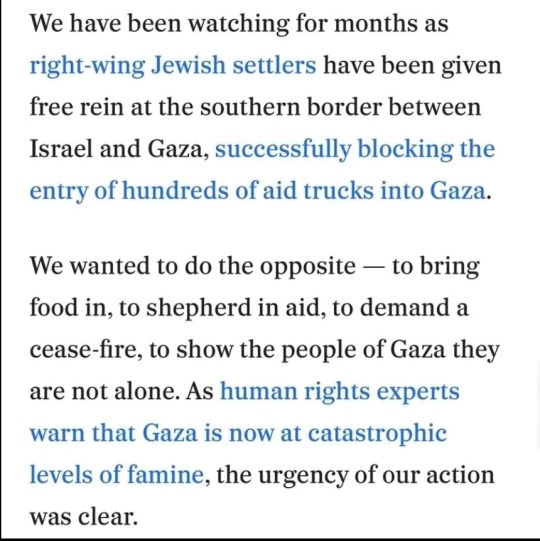

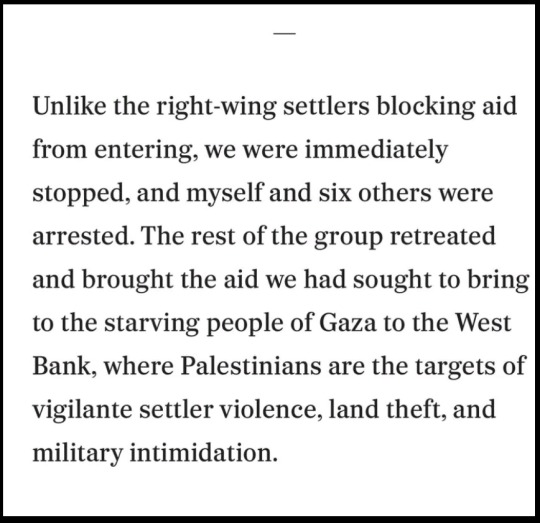

This act of resistance and kindness is Judaism.
israels religion is zionism. israel is an apartied ethnostate that does not represent Jewish people. It is not antisemitism to say so.
35 notes
·
View notes
Text
The Golan Trail: A trip report.
Ah, it’s like exercising the old muscles again, writing a report of a trip here. It feels oh so good. I love writing, yet find many excuses all of the time to not spend my time doing it.
I got the harebrained idea in my mind to hike the Golan Trail in four days. It’s 125K, so you can do the math. It’s basically going from 0 to 60, nothing to something significant. My roommate, however, came through big time. He ended up having pretty much all the gear I needed and more (blow up pillow? sit pad? wind screen?) and donated it to me for the few days I was going to be out in the woods. He is a tzaddik.
I took a bus up to Majdal Shams, a Druze city that is one of the most northern places in Israel. There I stayed in an Airbnb with Ahmed for the night. Ahmed showed up in a pickup truck after talking to the driver of the bus I was on, telling him to make a special stop for me by the gas station. He knows everyone in Majdal Shams, or so he says. “What a cute, petite guy,” he said of the bus driver.
Ahmed offered me whiskey and hookah and told me his family had lived in the area for 1,000 years.
Day 1
The next day, he said, I should call him after 9am so that he could pick me up and take me to the top of the hike, in the Hermon. When I (non-authentically) protested that that was out of his way, he dismissed me with a wave of his hand. “No other way for you to get up there,” he said. And so he drove me around the steep curves, up the mountain, and there I was, by the sign marking the top of trail. I couldn’t believe I had the gear, and the time, and the ability to do this hike - one I have wanted to do for quite a long time. I am incredibly lucky. And I was very happy.
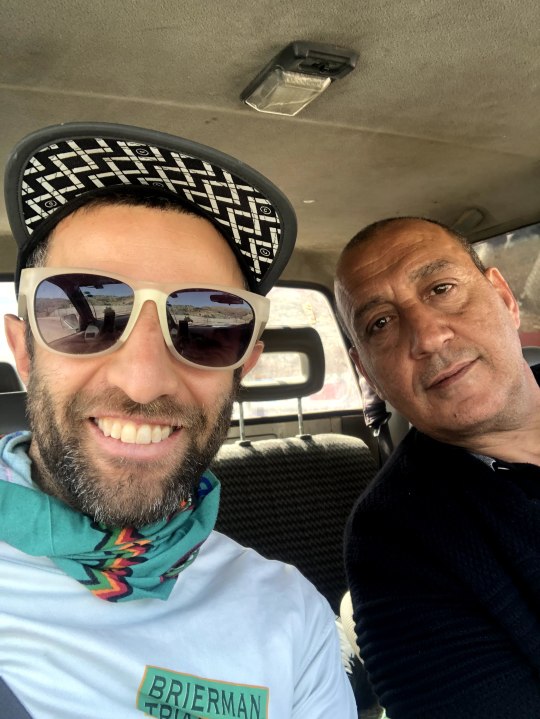
Me and Ahmed

The beginning.
My goal was to hit 31K per day - something around 19 miles. Each day, though, the morning was, for whatever reason, slow. I didn’t know this would happen on Day 1. But the section from the Hermon back down to Majdal Shams was probably one of the more difficult sections of the entire trail, at least in terms of technical descending. It’s also easy to lose the trail. Thankfully, I had the AllTrails app, which helped me out a ton (I promise I am not getting paid for this). The poles I got from my roommate were incredibly helpful, though. I think they may be a mainstay for me in the future.
It was beautiful, though. You’re up at 4500 feet or so, and you can see very far. The whole world is ahead of you.
I find that I get frustrated easily on these hikes. I spent a good 15 minutes at one point going back and forth, trying to find the trail that really wasn’t so difficult to locate. I think I’m pretty bad with directions in the wilderness, for whatever reason. But I got to the bottom of the section, and so began a relatively easy next few kilometers, through Kibbutz Nimrod, Masa’ade, and around a reservoir. Before Nimrod, there’s a point where you can see Kiryat Shemona, Metula, and into Lebanon. It was a lot of downhill on a road, and then it started to go up again after Masa’ade. The landscape was wide open, and you could see pretty much everything around you, including the snowy Hermon peaks, Majdal Shams resting comfortably on the hill, nearby mountains, and so on. It was kind of hazy though.

The view into Lebanon.

Majdal Shams and Hermon.
The climbing wasn’t hard, but it was there. I stopped for lunch near some cows. It was getting a bit late in the day, and by this point I was getting nervous for timing. I had wanted to get to a point where the trail crossed Route 98 (the highway the trail skirts for most of the way), but I wasn’t sure if that was going to happen.
The climb then continued, all the way up to Har Odem, which is a bizarre tangle of mining sites and some sort of other contraptions on top. From there, you get a whole other viewpoint south. You really started to see what was left of the Golan, what you had in front of you, what was coming. Mini-volcanic peaks, grasslands, and so on and so forth.

Har Odem.
From there, there was a slight descent. Birds were chirping, and it was beautiful. I still felt pretty good physically and was simply trying to make good time at this point. I knew there was a climb coming my way, but it took longer to get there than the map indicated. A road goes around Har Hermonit to avoid a military installation on top, and so I took that, and hit the top at about 4:30pm - about an hour and a half of daylight to go. But when I looked at the map, it said I had gone a full mile less than what my watch was telling me. I was certainly concerned at this point - everything really had to go perfectly for me to finish in four days.
From here you could see straight into Syria.
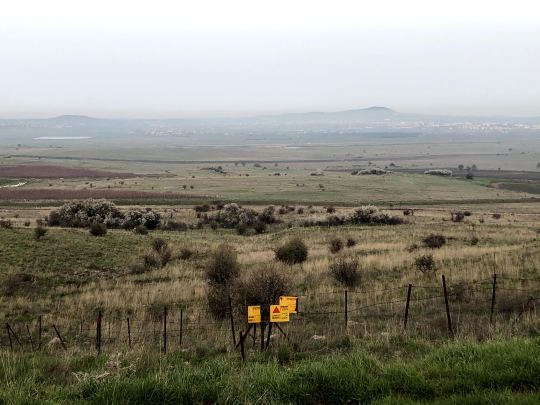
Looking into Syria - signs for land mines.
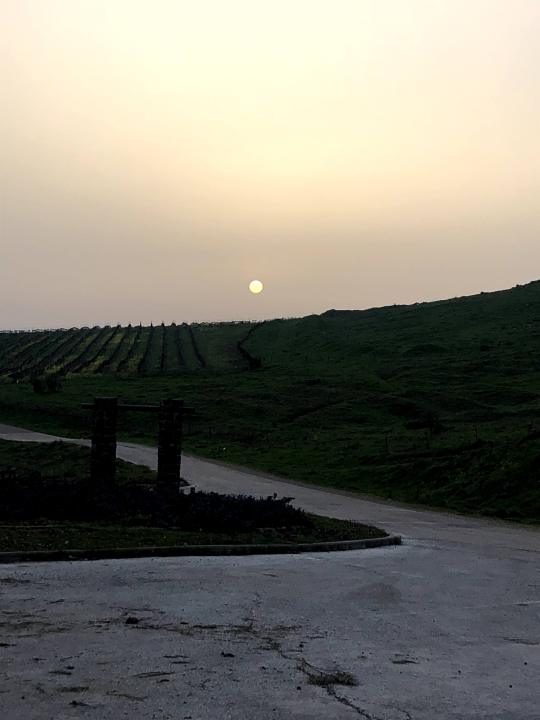
Hazy sunset.
I got lost at one point, but by virtue of getting lost I passed a sign that told me I was entering the Emek HaBacha - Valley of Tears, so named for being the site of a major battle in the 1973 Yom Kippur War. Now it’s home to the Golan Heights Winery and many wind turbines.
It was getting dark, but I realized I was within a mile of the point I wanted to get to that night. I didn’t quite make it all the way to the road, but I got even closer, and found a nice grassy patch by the site of the trail where I decided to spend the night. After setting up the tent, cooking, and taking care of some phone business (I hate having to use my phone while hiking or camping, but too much was going on in the world that day for me not to, in terms of many things in my life) it was already 9pm by the time I crawled into the tent. Still, I felt OK, physically, and knew I had a long next day ahead of me.
Day 2
It took me a little while to get out of bed this day. By the time I did all the morning things, it was already 8:45am. That was when I left - later than I wanted to. I knew I was near the town of Merom Golan, and I was hoping to reup on water there (that’s basically how you do it on this trail; there aren’t THAT many water sources, plus I thought I brought iodine with me, but it turned out to be iodine neutralizing flavor tabs, which don’t make water clean, so, yeah...).
Again I got lost and walked 0.6 miles out of the way, which doesn’t sound like much, but feels like a lot when you have a tight schedule. I walked back, though, and then encircled a reservoir, and eventually arrived at the base of Har Bental, the steepest climb of the trail. It was certainly steep, but the trail was lined with flowers (I haven’t even talked about those yet, they are everywhere; red, purple, white, etc.) and it was a lovely time. There’s also a coffee shop on top called Coffee Anan (a three-way pun, by my count). I duly purchased a cappuccino and filled up on water there.
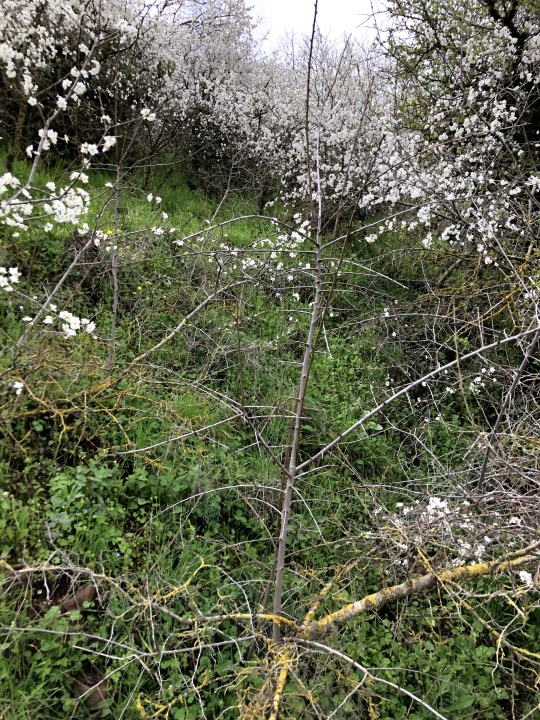
Har Bental flowers.
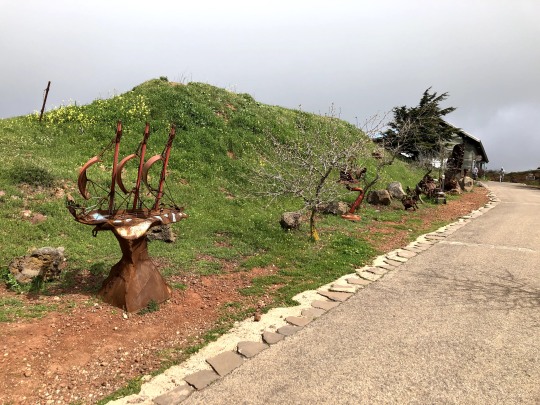
Sculptures at the mountaintop.
I then kept a fast pace through to the point where I next crossed Route 98, which was already 10 miles in. It was through red flowery fields, and it made for fast walking. This was the first time, though, that I noticed that my left shoe was starting to come undone (the toebox was starting to flap open), and that was scary. I also felt some blisters starting to form.
But things kept going. A friend actually met me for a short part of the trail here, and had a car, so I was able to drop my pack in the car and continue on (we met up along the trail, but the car ended up being parked near that night’s camping spot). I flew through the next miles, even though there were three separate small climbs. It went fast, and I felt pretty good, even all the way up to Mile 16. More views of Syria from the top of the climbs.
After descending the final climb (Har Chozek) I ended up in a grassy field, and it was just so peaceful. Cows lounged around, and I even saw some wild horses. You could still see pretty far into the distance, but there was green all around you. I was quite happy.
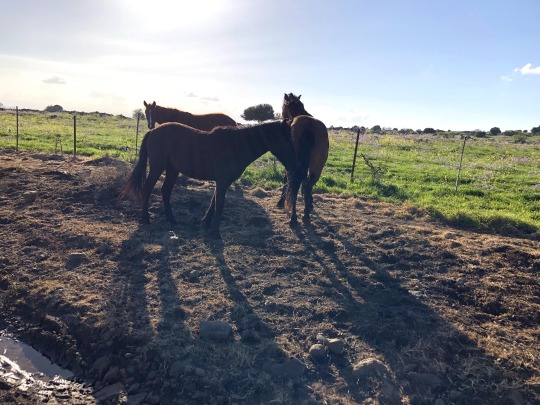
Wild horses.

All day, every day.
This was my longest day, but physically I felt mostly OK, although I did notice I was starting to feel pretty tight. My feet were hurting, and I had blisters. My shoes weren’t in great shape. When I didn’t move anywhere for 10 minutes and then moved again, I felt like I couldn’t walk so well. And I still had two days to go. It didn’t feel all that promising at this point.
This was also quite a chilly night. I slept through the night, but the camping spot at Choresh Chushnia wasn’t so great (lots of wonderful cow poop smells), and foxes were howling very near us. At one point my headlamp caught their eyes, and all I saw were two beady red dots in the distance, staring at me. Spooky! There was a small moon, though, and the stars were out, and there was a wide open sky. Perfect.
Day 3
The elevation profile for this day told me that it would be all downhill. That wasn’t really true, but any climbing that happened on this day really wasn’t so bad. I was counting on blowing through this day quicker than the others, though, especially after a relatively slow start. That did not happen.
Cattle gates. Endless. I didn’t take a picture of one, probably because I was just constantly frustrated by them. You turn to your left, pass through the first part of it, oh, watch out for that barbed wire, turn to your right, make sure you don’t tear the sleeping pad bound to your pack, oh, you can’t fit through? Take off your pack, lift it above your head, risk your back health, and take valuable time.
And repeat the same thing 400 meters later.
So that was annoying. The hiking was also on top of a mini-ridge that followed a stream. It was certainly beautiful, but it was a bit slow. There was one point where I went the wrong way and ended up walking through a barbed wired surrounded gate into a wet stream, another time where I slipped and my feet were muddied (remember, my shoes were falling apart at this point). I was frustrated.
But I found a mini-waterfall in which to swim. The hiking was beautiful - real grassland hiking, long plains stretching out westward and forever. There is also a strange, Stonehenge-like arrangement of rocks at one point along the trail (called Rujum al-Hiri), which historians cannot really explain. Combine that with faster walking in the middle part of the day and I was in a better mood by lunchtime.

Grassland hiking.

Swimming waterfall.
I went around another reservoir and found myself next to a large canyon right around the time to break for lunch. That canyon came out of nowhere, and it was stunning. The trip guide told me I would have an opportunity to hike down into the canyon (here it was called the Gamla Natural Reserve) and I was excited to do so.
But I was pretty tired at this point. This was the point where really everything started to hurt. My feet, my heels, every muscle in my legs, muscles that I didn’t even really know I had.
Still, the walking was good after lunch. I kept a consistent pace, and made decent time, even though I was hurting. It was only when I started to go down towards the canyon that I started to feel that familiar marathon-race type pain, the one where your body simply wants to shut down but you have to push through it. It was scary, a little bit. I was not feeling good, and I still had a long ways to go. And I could see the sun starting to drop in the sky, just a little bit.
But the canyon was honestly maybe the most beautiful part of the entire trip. Cows grazing, red flowers, lush greenery - and, at the bottom, a shaded water crossing that led to the Syrian Bridge crossing in the area (unclear to me, exactly, its historical significance).

Look closely and you’ll see red.

Awesome river crossing.
From there, another climb. After the climb, I got my first view of the Kinneret of the entire trip - a goal to work towards. I was exhausted, though - I was about to hit 17 miles on the day, and wasn’t sure where I would camp.

Kinneret visible between the mountains.
I reached the end of that particular hiking section, though, and it informed me that after a 2 mile descent, I would reach sea level, and a camping spot (at Mifgash HaNachalim, where two streams would meet). I had enough daylight for that left - about an hour. I walked (poorly) downhill for two more miles, and made it - but was met at the bottom with three water crossings. I took my shoes off for the first one, but the next two I plodded through - I was too tired at this point to keep taking my shoes off and putting them on, especially when the shores themsleves were probably my biggest burden at this point.
At the campsite, a father-son duo watched me as I trudged through the final water crossing. “Why did you go through the water?” they asked. “There is a way around!”
The final insult. There always is one.
I cooked dinner, put up my tent, and finally got my shoes off. An unbelievable feeling. My feet were wet, blistered, and doomed to remain wet for the rest of the trip, I knew. One more day, though. Another 20 miles, but one more day.
(I heard some suspicious panting outside my tent, though, and thought for a second it might be a wild boar. But, in the end, nothing happened.)
Day 4
I needed to get out early on this day - and I basically did. I was out and hiking by 7:30am, but not before hearing some rain pitter-patter on my tent in the morning. Luckily it only lasted a minute or two. It didn’t matter, really - everything was basically wet and muddy at this point.
The morning began with a climb, which went fine. But I got lost (thank you to the angel at the top of the climb who pointed me in the right direction) and then, while hiking though heavy underbrush, lost again. I tried to bushwhack to find the trail, but it was no use. The trail was nowhere to be found. This was insanely frustrating, but fit in with the common theme of unexpectedly difficult mornings the entire trip.
But I was able to stay on some sort of dirt path and make my way uphill toward Givat Yoav - a kibbutz. I had to open and close a few gates to get there, but once I was there, I was near the trail again. There had been more views of the Kinneret along the way.
Getting lost had cost me some mileage, but it also put me further along the trail, meaning there was a small section that I actually didn’t end up doing. I’m intense about such things, and spent brain power feeling bad that I had “skipped” part of the trail - the part that went very close to the Kinneret, no less. (I felt better when later in the day I met someone else who had also gotten hopelessly lost in the same place.) And, in Givat Yoav, a very nice young man offered me water, and I got a chance to look at the kibbutz sheep. Overall, an insanely peaceful time.

Morning viewz.
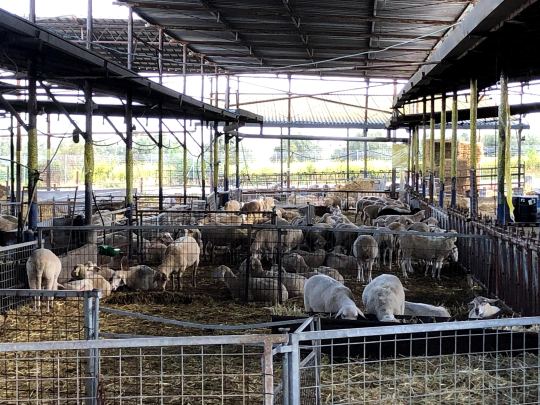
Givat Yoav.
I did take a small side trip to check out the section I had skipped (after I took my pack off). My bad side told me I hadn’t done the whole trail since I had skipped it - but I ended up doing more than the mileage the trail actually is, so I choose to not believe that bad side of myself. I did the whole trail, dammit.

“Skipped” section.
From there was a long down and up to the Golan Amphitheater. The trail moved away from the Kinneret side, eastward, and went down a long descent past other kibbutzim, before eventually making its way uphill to that spot. It didn’t take that long, though, and there were plentiful flowers along the way. With about 8 miles left, I was starting to smell the end. I ate a three-tortilla lunch and took a little more time than normal at lunch. I’m good, I thought.
I thought the next section would be similar to the last - a long descent, followed by a long ascent, not too bad. And that is basically what it was - but the long descent was technical, down to Meitzar Stream, and then the walking along the stream was covered in low trees and grass. Not the fastest hiking - but honestly some of the most lush, stunning landscapes of the whole trip. Everyone should go to Meitzar Stream - just a beautiful waterway nestled inside the Golan.
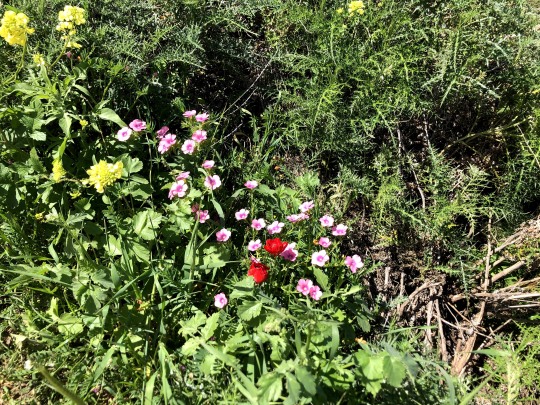
Golan flowers.
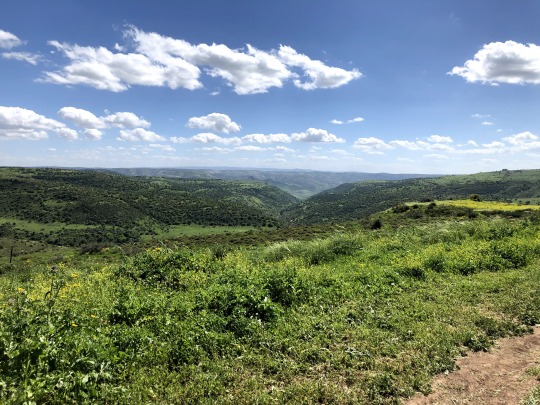
Top of Nachal Meitzar.

The Meitzar trail.
It was slow hiking, and then to climb out of there, you had to hike up a long, paved road that led you back up to the plain. That was endless and at this point I really could barely move. Someone offered me a ride - how tempting! But in the end, I saw the top, and to my left, Syrian villages were visible, beyond them Jordanian mountains. I knew I had a Kinneret view coming up to me soon - even though I got lost one more time and had to walk an extra half mile, just for good measure.
When I arrived at the last trail section (I don’t think I mentioned the trail is divided up into 15 sections, with moderately inaccurate information on each side that introduces each section) I knew I had 5K to go, even though the sign was telling me 7K (blatantly false).
I allowed myself to smile a bit on the easy way down to Ein Teufik and to the bottom of the hike. I had done this section with my parents a couple of years ago, and while not the most impressive trail, you do get amazing Kinneret views. I saw people doing some sort of paragliding in the sky. “You look tired,” one guy watching the spectacle said to me. And I was.

At the end.
I met a couple guys at the end of the hike who had taken five days to do the whole trail. In retrospect, four days was crazy. I sit here four days later and I still am sore (although a massage last night helped a bit). Still, they accompanied me to the end, and it was nice to have partners in crime to finish the trail with, with a big whoop at the finish.

There were certainly points where I didn’t think I would make it.
We all needed to hitchhike down from the trail. Within 15 minutes, I was in the car with a very nice couple who drove me way further than I had expected - all the way to the airport area, where I caught a bus back to Jerusalem. I sat in their car, eating kohlrabi they offered me, pleased to be off my feet, looking forward to that best moment - when I would peel off my wet socks and the underfitted shoes on my feet and sit down, in a room, just for one second.
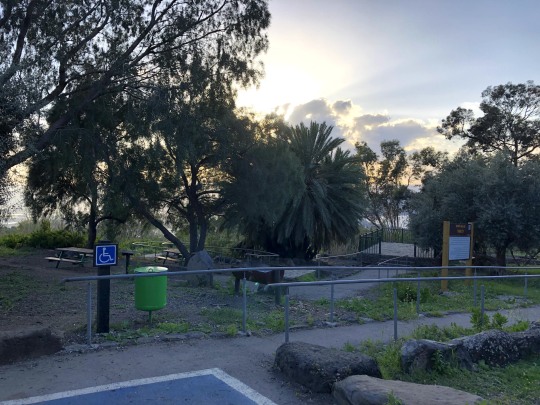
Hitchhiking from here.
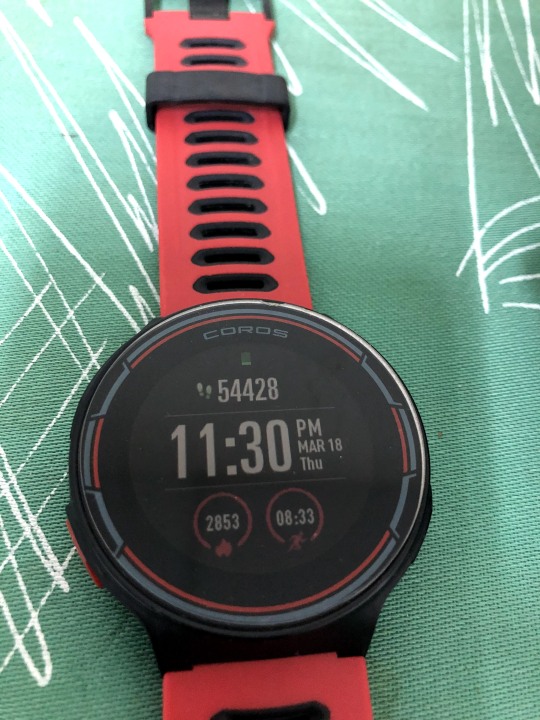
54,000 steps in a day - maybe a record?
In the end, of course it was worth it. I think I get frustrated easily by little things on these hikes, and judge myself for not going as fast I the impossible standard I hold myself to. I don’t always see the green that is inevitably there. A lesson - to take deep breaths, know that it’s going to work out, even if the sun is setting and you’re getting lost and your feet hurt. It’s really OK - more than OK, really. Downright flowery and beautiful.
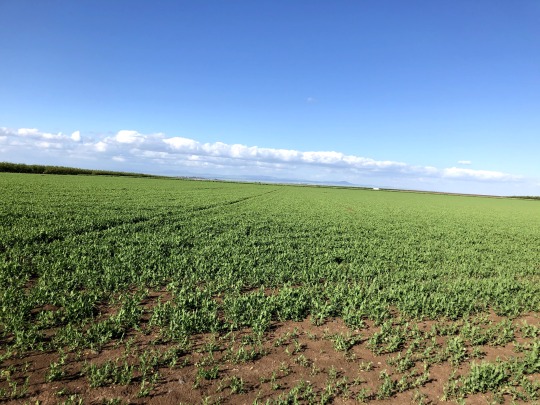
0 notes
Text
Expert: On April 9, 2018 at least 14 people were killed during the murderous strike by the Israeli air force on the Syrian T-4 airfield at Homs. Israeli F-15 fighter jets flew over Lebanese airspace, as they have done on many previous occasions, in total disregard of international law. Both Israel and Lebanon are still technically at war, and the latest action could easily be considered as yet another shameless provocation. Apparently, whatever terror Western allies like Saudi Arabia and Israel decide to spread throughout the region, their actions will always go unpunished. To add insult to injury, instead of condemning Israel, the Western mass media outlets began their predictable and embarrassing servile howling against the government in Damascus, some ‘correspondents’ even calling President al-Assad an “animal” (The Sun, 9th April, 2018). This time, Lebanon, which in the past suffered from several brutal Israeli invasions, and where Israel is commonly referred to as ‘Palestine’, decided not to protest too loudly against the violation of its airspace. There were some statements made by individual Lebanese politicians, as well as a statement by the Lebanese Ministry of Foreign Affairs, which objected to the attack against Syria, claiming that Lebanon will file a complaint to the UNSC. Most of the statements, however, appeared only in the Arabic language. There was definitely no robust national response, as one would have expected. Ms. Zeinab Al-Saffar, an Iraqi educator and television anchor based in Beirut, Lebanon, shared her thoughts on the subject: It is not the first time that this is happening. Israeli forces have been violating the airspace of Lebanon, as well as the land and sea belonging to Lebanon. Violation of the territory of Lebanon [by Israel] became something ‘regular’. What happened recently is a flagrant intrusion which should not go unanswered, as they were using Lebanese air space in order to attack the Syrian land. I believe this is the right time for the U.N. to do something more than just to make the reports and write numbers. This is an extremely serious situation; to use the territory of a neighboring country in order to attack a third nation; it is a barefaced crime. ***** Why do Lebanon’s protests not resonate louder? There are several reasons. One: the country recently ‘secured’ an enormous package of mostly loans from the West, at a ‘Paris conference’, amounting to more than 11 billion dollars. Two: A great percentage of the ‘elites’ of Lebanon is accustomed to taking orders from the West. The West is where their villas are, where their relatives live, and their permanent residency cards issued. A much greater war may be nearing; both the U.S. and Europe are now attacking Syria directly. In this decisive time, the Lebanese rulers are opportunistically showing where their allegiances lie: not with the people of the devastated Middle East, but with Paris, London, Riyadh and Washington. But back to the first point – to money. As reported by Reuters on April 6, 2018: “The pledges include $10.2 billion in loans and $860 million in grants, France’s ambassador to Lebanon Bruno Foucher said on Twitter…” Donors in turn want to see Lebanon commit to long-stalled reforms. In a nod to those demands, Prime Minister Saad al-Hariri pledged to reduce the deficit of the budget as a percentage of GDP by 5 percent in the coming five years. Macron told Hariri in a news conference the aid aimed to give Lebanon a fresh start, adding that it put “an unprecedented responsibility” on authorities there to carry out reforms and preserve peace in the country. “It is important to continue reforms in the coming months,” Macron said, adding: “We’ll be by your side.” … French Foreign Minister Jean-Yves Le Drian told the conference: “… Lebanon needs major reforms of its economy, structural and sectoral.”” ‘Structural reforms’ is a key term. This shameful package of loans which will further tie the hands of Lebanon could insure the complacency of the country: both economic and political obedience at the time when the West is ready to unleash a new wave of its military onslaught in the region. There is hardly any transparency in Lebanon, and therefore almost no guarantee that the loans will be used to improve the standard of living of the suffering population. Corruption in Lebanon is endemic – it is institutionalized – to the point that it is often not even called ‘corruption’ anymore. Social services are almost non-existent. Here, the contrasts are truly appalling. Ferraris and Lamborghinis, as well as outrageously expensive sailing boats, co-exist side-by-side with absolute misery and lack of social services, such as, at least periodically, garbage collection. Hezbollah, a movement which is on the so-called terrorist list of many Western countries, is often the only reliable source of social services in the country. The West will now demand more and more neo-liberal ‘reforms’. Almost nothing social will be built. Funds will disappear into the deep pockets of the shameless Lebanese ‘elites’ and ‘leaders’. It will be the poor, who will be expected to service the loans, as the rich in Lebanon hardly pay taxes. In exchange for their booty, many Lebanese politicians will be further obliged to follow the Western line towards the region, including the neo-liberal and increasingly neo-colonialist policy of Washington and France (Lebanon’s former colonial master) towards Syria and the rest of the region. ****** And across the border line, the war is still raging. Washington and London fulfilled their shameful promises to perform ‘punitive actions’; to ‘chastise Syria’ for something that was clearly invented/manufactured just in order to justify an invasion, destabilization and in the end, the destruction, of this small but strong and proud nation. A Syrian intellectual, who lives in both Beirut and Damascus, offered his analyses for this article. However, he requested not to be identified by his name, afraid of repercussions from both Lebanon and the West: The Israeli attack comes at a time when the Syrian army is winning its fight against terrorist groups in Damascus suburbs, and it could be read as an indirect answer to these wins. It is also a dangerous move since the T4 airbase is heavily involved in the fight against the remaining of ISIS in Syria. This attack is unacceptable aggression against a sovereign nation and it is a violation of international laws. It also shows that Israel is helping directly and indirectly various terrorists groups operating on the Syrian territory. ***** However, the commentaries that are being spread by the Western mainstream press are increasingly defying all logic. They are progressively turning out to be racist, supremacist. Well, actually now they are what they have always been earlier, throughout the centuries of European and then North American colonialism. In Damascus, shelling a park right next to the Four Seasons Hotel, the UN acommodation from East Ghouta Just read The Guardian article from April 9th, 2018- “Israel has launched countless strikes in Syria. What’s new is Russia’s response”: Israel has launched many previous strikes into Syria, mainly to protect its borders from a buildup of Iranian-backed Hezbollah forces and armaments on the Golan Heights. Israel, has not, as a rule, attacked al-Qaida or Islamic State positions in Syria. On all previous occasions, Russia – which has controlled Syrian air space since it sent troops to defend the regime of Bashar al-Assad in 2015 – has turned a blind eye. There had been an understanding that Israeli interests in Syria would be preserved by Russia, primarily by limiting the presence of Iranian-backed troops in Syria’s south-west. The Israeli fear is that access to the Syrian side of the Golan Heights allows Hezbollah to launch attacks into Israel. At least The Guardian does not pretend that it believes in the Western fabrications that President Assad is poisoning his own people… But the article is clearly trying to justify and find logic behind the Israeli terrorist attacks against the independent nation. ‘Poor Israel – it is worried about ‘Hezbollah forces and armaments on the Golan Heights.’ Spy-surveillance base on the hill overlooking Syria But the Golan Heights is by international law an inseparable part of Syria. I repeat: by all international norms! Including, the United Nations Security Council UN Resolution 497. Golan Heights had been attacked, occupied and forcefully (and it looks like indefinitely) annexed by Israel, during the so-called ‘Six-Day War’ in 1981. I visited the Golan Heights. I worked there, for several days, clandestinely, some 5 days ago. What I encountered there was true horror: ancient villages were totally destroyed, most of the original population deported from their land, Israeli-paid spies and provocateurs approaching and scrutinizing random visitors. All around – scattered rich Israeli agricultural enterprises protected by barbed wire and tall concrete walls. It all felt like working in Angola or Namibia, during the South African apartheid, or perhaps even worse; divided communities, stolen land, electric wire, and omnipresent fear and oppression. Horrid border at Majdal al-Shams But it is Israel which now has the right to ‘worry’ and to murder people in the name of its ‘security’. That is precisely what the tone of the Western mainstream periodicals clearly suggests. Israel had stolen more than a thousand kilometers square of the Syrian territory in 1981, and now it is mercilessly bombing its victim; from Lebanese territory, in order to assure its ‘safety and security’. It is doing so from the territory of Lebanon, a country which was invaded by the Israeli military, on several occasions. And the West is cheering. ***** Of course, Israel is acting with total impunity, because it enjoys both the support and encouragement from its allies: The United States, the U.K. and Macron’s France. Lebanon is panicking. Its’ ‘elites’ are trying to both survive, and not to anger the West. Syrians have, it often appears, nerves of steel. They worry but are determined not to give one single inch of their land to the invaders. My friend in Damascus wrote to me, just a few hours before I submitted this report: People are worried and they constantly follow up the news. My brother asked us to go to Safita for one month, as it is safer there. I’m not sure if we do it, but we are closely monitoring the situation. My colleagues and comrades on the ground in Syria are angry, very angry. They can clearly see through the lies, which are being spread by the West. Israel is repeatedly bombing heroic Syria. On April 29, 2018, the Israeli attacks killed 26 Syrians and Iranians, just before Midnight, near Hama and Aleppo. The U.S. and Europe are bombing and threatening to cause even more damage. But this is 2018, not those dark years when the West could murder and rape without any consequences. If these attacks continue, there will be a counterpunch: fully justified, determined and powerful. Then even the tiny Lebanon would have to decide where it stands. ***** • First published by New Eastern Outlook – NEO • Photos by Andre Vltchek http://clubof.info/
0 notes
Text
yeah, the evil Jews were all calling for — oh I guess you said defending, not that that’s really any better — the deaths of Palestinian children. sure.
You aren’t jewish, so you don’t get to determine what antisemitism is.
nothing Jews do can be right for you or other leftists. If we’re silent about the Druze (which we’re not going to be, obviously) then we don’t care about anyone but ourselves. If we talk about the attack on the Druze, we still only care about ourselves. That about sum it up?
sorry but fuck the entire world for their silence concerning what happened in majdal shams. fuck you all fuck you fuck you so so much. i thought you cared about children??? thought you cared about “brown children”??? huh??? nothing??? fuck you.
263 notes
·
View notes